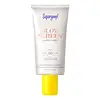Kiehl's Ultra Facial Cream Versus Supergoop! Glowscreen Hydrating And Glowing Sunscreen Primer SPF 30
What's inside
What's inside
 Key Ingredients
Key Ingredients

 Benefits
Benefits

 Concerns
Concerns

 Ingredients Side-by-side
Ingredients Side-by-side

Water
Skin ConditioningGlycerin
HumectantCyclohexasiloxane
EmollientSqualane
EmollientBis-PEG-18 Methyl Ether Dimethyl Silane
EmollientSucrose Stearate
EmollientStearyl Alcohol
EmollientPEG-8 Stearate
EmulsifyingMyristyl Myristate
EmollientPentaerythrityl Tetraethylhexanoate
EmollientPrunus Armeniaca Kernel Oil
MaskingPhenoxyethanol
PreservativePersea Gratissima Oil
Skin ConditioningGlyceryl Stearate
EmollientCetyl Alcohol
EmollientOryza Sativa Bran Oil
EmollientOlea Europaea Fruit Oil
MaskingChlorphenesin
AntimicrobialStearic Acid
CleansingPalmitic Acid
EmollientDisodium EDTA
Acrylates/C10-30 Alkyl Acrylate Crosspolymer
Emulsion StabilisingCarbomer
Emulsion StabilisingPrunus Amygdalus Dulcis Oil
Skin ConditioningXanthan Gum
EmulsifyingEthylhexylglycerin
Skin ConditioningSodium Hydroxide
BufferingTocopherol
AntioxidantGlycine Soja Oil
EmollientPseudoalteromonas Ferment Extract
HumectantMyristic Acid
CleansingHydroxypalmitoyl Sphinganine
Skin ConditioningBHT
AntioxidantSalicylic Acid
MaskingCitric Acid
BufferingWater, Glycerin, Cyclohexasiloxane, Squalane, Bis-PEG-18 Methyl Ether Dimethyl Silane, Sucrose Stearate, Stearyl Alcohol, PEG-8 Stearate, Myristyl Myristate, Pentaerythrityl Tetraethylhexanoate, Prunus Armeniaca Kernel Oil, Phenoxyethanol, Persea Gratissima Oil, Glyceryl Stearate, Cetyl Alcohol, Oryza Sativa Bran Oil, Olea Europaea Fruit Oil, Chlorphenesin, Stearic Acid, Palmitic Acid, Disodium EDTA, Acrylates/C10-30 Alkyl Acrylate Crosspolymer, Carbomer, Prunus Amygdalus Dulcis Oil, Xanthan Gum, Ethylhexylglycerin, Sodium Hydroxide, Tocopherol, Glycine Soja Oil, Pseudoalteromonas Ferment Extract, Myristic Acid, Hydroxypalmitoyl Sphinganine, BHT, Salicylic Acid, Citric Acid
Water
Skin ConditioningOctocrylene
UV AbsorberButyloctyl Salicylate
Skin ConditioningEthylhexyl Salicylate
UV AbsorberPropanediol
SolventHomosalate
Skin ConditioningGlycerin
HumectantButyl Methoxydibenzoylmethane
UV AbsorberC12-15 Alkyl Benzoate
AntimicrobialGlyceryl Stearate Citrate
EmollientIsododecane
EmollientNiacinamide
SmoothingPolymethylsilsesquioxane
CI 77163
Cosmetic ColorantMica
Cosmetic ColorantCI 77891
Cosmetic ColorantCaprylic/Capric Triglyceride
MaskingCetyl Phosphate
EmulsifyingLeuconostoc/Radish Root Ferment Filtrate
AntimicrobialLimonium Gerberi Extract
Skin ProtectingPantothenic Acid
Skin ConditioningPhospholipids
Skin ConditioningSodium Hyaluronate
HumectantTheobroma Cacao Seed Extract
AntioxidantTocopherol
AntioxidantTrisodium Ethylenediamine Disuccinate
CI 77491
Cosmetic ColorantWater, Octocrylene, Butyloctyl Salicylate, Ethylhexyl Salicylate, Propanediol, Homosalate, Glycerin, Butyl Methoxydibenzoylmethane, C12-15 Alkyl Benzoate, Glyceryl Stearate Citrate, Isododecane, Niacinamide, Polymethylsilsesquioxane, CI 77163, Mica, CI 77891, Caprylic/Capric Triglyceride, Cetyl Phosphate, Leuconostoc/Radish Root Ferment Filtrate, Limonium Gerberi Extract, Pantothenic Acid, Phospholipids, Sodium Hyaluronate, Theobroma Cacao Seed Extract, Tocopherol, Trisodium Ethylenediamine Disuccinate, CI 77491
 Reviews
Reviews

Ingredients Explained
These ingredients are found in both products.
Ingredients higher up in an ingredient list are typically present in a larger amount.
Glycerin is already naturally found in your skin. It helps moisturize and protect your skin.
A study from 2016 found glycerin to be more effective as a humectant than AHAs and hyaluronic acid.
As a humectant, it helps the skin stay hydrated by pulling moisture to your skin. The low molecular weight of glycerin allows it to pull moisture into the deeper layers of your skin.
Hydrated skin improves your skin barrier; Your skin barrier helps protect against irritants and bacteria.
Glycerin has also been found to have antimicrobial and antiviral properties. Due to these properties, glycerin is often used in wound and burn treatments.
In cosmetics, glycerin is usually derived from plants such as soybean or palm. However, it can also be sourced from animals, such as tallow or animal fat.
This ingredient is organic, colorless, odorless, and non-toxic.
Glycerin is the name for this ingredient in American English. British English uses Glycerol/Glycerine.
Learn more about GlycerinTocopherol (also known as Vitamin E) is a common antioxidant used to help protect the skin from free-radicals and strengthen the skin barrier. It's also fat soluble - this means our skin is great at absorbing it.
Vitamin E also helps keep your natural skin lipids healthy. Your lipid skin barrier naturally consists of lipids, ceramides, and fatty acids. Vitamin E offers extra protection for your skin’s lipid barrier, keeping your skin healthy and nourished.
Another benefit is a bit of UV protection. Vitamin E helps reduce the damage caused by UVB rays. (It should not replace your sunscreen). Combining it with Vitamin C can decrease sunburned cells and hyperpigmentation after UV exposure.
You might have noticed Vitamin E + C often paired together. This is because it is great at stabilizing Vitamin C. Using the two together helps increase the effectiveness of both ingredients.
There are often claims that Vitamin E can reduce/prevent scarring, but these claims haven't been confirmed by scientific research.
Learn more about TocopherolWater. It's the most common cosmetic ingredient of all. You'll usually see it at the top of ingredient lists, meaning that it makes up the largest part of the product.
So why is it so popular? Water most often acts as a solvent - this means that it helps dissolve other ingredients into the formulation.
You'll also recognize water as that liquid we all need to stay alive. If you see this, drink a glass of water. Stay hydrated!
Learn more about Water